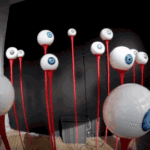2D Boy has come out with a new game called Robot and the Cities That Built Him this last week. I highly recommend the game, it’s a lot of fun and very stylized looking flash game. I played all the way to city 57 before setting it down, with my squadron of robots fully upgraded and eliminating everything in their path. Even more impressive, the game was built in seven days.
As it is with well built flash games the simplicity allows the player to really see the breakdown of game elements, how they fit in and how they create the game experience. “Robot” is not a completed game, so not all the elements are there and, if you do well and get to the later cities, you’ll see not all the balance elements are in place either.
However, it is interesting to take a look at the beginning of the game, as you build up your robot army and upgrades. The game has resources (the hearts that drop upon killing people and helicopters), units (the two available robots), rewards (more robots, upgrades, robot upgrades), and a system that forces you to use the resources, giving them value.
The resources–which come faster the better your units are and the more successful you are–can only be picked up by running the mouse over them, forcing you to manage your time between monitoring your robots, buying upgrades, and picking up the resources. This adds challenge to the game while restricting the players ability as the difficulty ramps up, you cannot manage a certain number of robots (to repair them, they have to be picked up by clicking on them) and pick up the resources required to repair them at the same time, especially early on, when you cannot kill things fast enough to get resources.
The two units, Perfect Bot and Clampy Bot, have two completely different functions, with each giving you a reward for using that bot, while punishing you if you do not use it. In any game, especially ones with a small number of units, it is important to force the player into using the units and creating a balanced game. Once you get outside of the basic formula of Archers, Ranged Calvary, Infantry, Heavy Calvary, Artillery unit balance, this sort of thing can become very difficult, and many an RTS has failed at providing such a balance.
There is the possibility of different units providing different measures of each role, meaning that a strategy can come into which type of each basic unit you use, but that tends to fail more often then not, and is extremely difficult. Here there are only two units, Clampy Bot (who you start off with) is your basic unit, he kills the little people below. Without him you get no resources and no protection from what appears to be enemy laser stick figures and ninjas. The other unit, Perfect Bot, must be purchased as the game goes on. However, in the early game he is especially rewarding, as he burns down buildings, releasing more innocent civilians to fry with Clampy Bot, meaning more resources. He becomes required later in the game, as he is the unit that can take down the deadly attack helicopters.
See the balance? By the time I ended the game, I had two of each robot, positioned with two Perfect Bots sandwiched between two Clampy Bots, letting me cover the Perfect Bots from the people on the ground while they took down the helicopters attacking my lead Clampy Bot. Positioning of each bot was also important for success, as each had a limited range.
The reward system is obviously only just starting to come into place, you can upgrade each robot, firing speed, and repair speed. Each upgrade has obvious and tangible results, giving value to the spent hearts and making them something important to your success as a player. This is also another thing that you can spend resources on, once again adding to the things the player must manage and worry about as the game continues.
Ignoring the parts towards the end, as you hit the obviously incomplete part of the game, you can see that the game does not allow you to stockpile resources, forcing the gameplay forward and keeping the player engaged. The robots require the hearts, not just for upgrades, but for repairs as well. Perhaps the most important balance element that 2D Boy has added here is the fact that even when the robots are doing nothing but walking forward they slowly become damaged, necessitating repair. This means the resource drain is constant, forcing accompanying constant player interaction, a recipe for success.
I don’t know about you but I currently hope that 2D Boy goes forward and puts a little bit more work into the game, I’d love to see what else they could add in while maintaining the balance that makes Robot and the Cities That Built Him such fun. It is great to see such an interestingly constructed, but simple game, and it provides a great example of the elements that developers have to think about in any game.




























